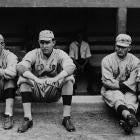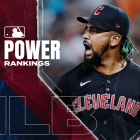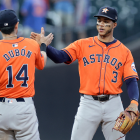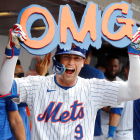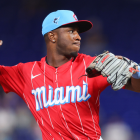It's an odd thing, that two franchises so storied and with so many overlapping glory years wouldn't have rushed headlong into each other in more than a century. The Dodgers date back to the 19th century, and the Red Sox trace their modern origins back to 1901. Even so, the 2018 World Series marks the first time these two have been the last two squadrons standing since way back yonder in 1916. Not surprisingly, a look back at that clash also provides an object lesson in how much the game has changed in the intervening 102 years.
Back in 1916, the Red Sox barged to the pennant in surprise fashion. The prior year they won 101 games during the regular season and took the World Series in five games over the Phillies. However, coming into the 1916 season they weren't regarded as favorites on account of trading away their star center fielder Tris Speaker to the Indians over a salary dispute. As well, Smoky Joe Wood's arm finally failed him after the 1915 season, which marked the end of his Boston tenure and in essence the end of his career. Still, the Sox won 91 games in 1916 and fended off the White Sox and Tigers thanks to a 19-9 mark in September. They did all that in part because a 21-year-old left-hander by the name of Babe Ruth enjoyed a breakout campaign on the mound: A majors-leading 1.75 ERA in 323 2/3 innings with 23 complete games and nine shutouts.
Across the way were the Brooklyn Robins. The Dodgers, of course, made Brooklyn their home before relocating to Los Angeles in 1958. For a time, they were known as the Robins in honor of manager Wilbert Robinson. Over the years, we've seen teams named after owners, coaches, and even players, but the extent to which the managerial class was exalted in those days was evident even on the cover of the World's Series program:

(Image used with permission of Robert Edward Auctions)
Nothing rouses the roost like headshots of managers, presidents, and owners, you know. Anyhow, in 1916 the Robins went 94-60, won their first pennant since 1900 and played in their first World Series (or "World's Series," as it was generally known in those days). Future Hall of Famer Zack Wheat paced the attack with an OPS+ of 150, and not far behind him was fellow outfielder Casey Stengel, age 25. The powerhouse rotation was fronted by Rube Marquard, Jeff Pfeffer, and Larry Cheney.
The 1916 Series took place against the backdrop of the deadball era, in which runs were hard to come by and home runs were impossibly scarce by modern standards. Within a few years, a tectonic shift in baseball would take place. The spitball was outlawed, save for a handful of pitchers who were "grandfathered" permission to use the devastating pitch. Rules mandated new baseball be put into play regularly during the course of a game, which meant -- wonder of wonders -- hitters could see the ball in the middle and late innings. In 1919, the construction of the baseball itself was improved and standardized, which resulted in a jumpier implement. On top of all this, the aforementioned Mr. Ruth made swinging for the downs the norm in baseball, and his approach at the plate grew to be widely imitated. Whether cause or consequence, the best pitchers -- i.e., starting pitchers -- during this time began working a smaller percentage of innings. All of it added up to a great leap in run-scoring and the sweeping diminishment of the "small ball" strategies that had not long ago carried the day.
The Robins-Red Sox encounter wound up going Boston's way in five games. The first three games of the series were each decided by a single run, but the last two provided little in the way of drama, as the Red Sox prevailed by a four and three runs respectively -- routs by the standards of the times.
The Dodgers wouldn't claim their first title until 1955, while the Red Sox would win again in 1918 and then, as the story goes, not until 2004. Speaking of time being the fire in which we burn, things -- as noted at the outset of this perambulation -- change. And things have certainly changed since last these two teams met for the belt and the title. To wit ...
Home runs
It's a power game, of course. It's been a power game for a long time, and it's now that more than ever. During that 1916 regular season, the Red Sox hit 14 home runs as a team, with a number of them never clearing the fence. And they weren't even last in the league (the Washington Senators hit 12). Ruth, the pitcher, tied for the club lead with three.
To put that in perspective, the 2018 Dodgers on three occasions this season hit half that total -- i.e., seven -- in a single game. Framed another way, the Robins/Dodgers and Red Sox in 1916 combined for 42 home runs. The Dodgers and Red Sox in 2018 combined for 443 home runs. In the 1916 World's Series, the two teams accounted for three home runs, two of which were inside-the-park. We'll very likely exceed that tally in Game 1 on Tuesday night.
Small ball
The inverse of the above is the decline of small ball strategies. The Robins and Red Sox in 1916 combined for 316 stolen bases in 156 regular season games apiece. This season, the Dodgers and Red Sox teamed up for 300. Wait, those are pretty close, no? Yeah, they are. Stolen bases, executed successfully at a high rate, still have value and a place in the contemporary game. Here, though, is where we really see the difference:
- The Robins and Red Sox in 1916 teamed up for 408 sacrifice bunts by non-pitchers.
- The Dodgers and Red Sox in 2018 teamed up for 15 sacrifice bunts by non-pitchers.
In the current environment, rich in runs and power, willfully giving up outs doesn't make sense. Time was when, though, it did.
Pitcher usage
In Game 2 of the 1916 World's Series, Ruth started for the Red Sox, thus making his World's Series pitching debut. Here's his final line for the game, a 2-1 Boston win:
14 IP, 6 H, 1 R, 4 SO, 3 BB
Yes, Ruth pitched all 14 frames. Along the way he faced 48 batters, and he got into the opposing order for a sixth time. Per a very basic pitch-count estimator, that comes to 171 pitches. Pitchers these days throw harder, throw a large percentage of breaking pitches that may stress the arm more, and face deep lineups that allow no opportunity to "take a batter off." Also, teams actually take the long view with their arms. For those reasons and others, such a workload is unthinkable these days.
In matters related, here's a list of every pitcher Red Sox manager Bill Carrigan used in this five-game series: Ruth, Rube Foster, Dutch Leonard, Ernie Shore, Carl Mays. Here are three of those four twirlers:

Yes, Carrigan went through five games of winner-take-all stakes and used five moundsmen. In contrast, Dave Roberts in the seven-game NLCS against the Brewers used 12 pitchers. In Game 2 alone, Roberts used eight different pitchers.
Framed another way, the Red Sox in the 1916 World's Series pitched 49 total innings, and starting pitchers worked 46 of those innings, or 93.9 percent. In the recently completed LCS round, the Dodgers and Red Sox combined for 110 innings pitched, and starters worked 68 2/3 of those innings, or 62.4 percent. It's a relievers game these days, especially in the postseason when managers are acutely focused on getting the next out and seizing the platoon advantage as often as possible.
Game times
So that 14-inning Game 2 noted above? It lasted two hours and 32 minutes. The decisive Game 5, which Boston won 4-1, spanned just one hour and 43 minutes.
In Game 4 of this year's NLCS, the score was 2-1 -- just as Game 2 of the 1916 World Series was -- and it lasted 13 innings. The run time? Five hours and fifteen minutes. Game 1 of the 2018 NLCS spanned the usual nine innings, yielded a 6-5 final score, and lasted four hours and two minutes. Game 1 of the 1916 World's Series also spanned the usual nine innings, yielded a 6-5 final score, and lasted ... two hours and 16 minutes.
Frequent pitching changes, longer between-inning breaks for TV commercials, more time between pitches, more pitches per plate appearances -- all of it contributes to the sprawl of the modern game. Nothing etches that in sharp relief quite looking back at the run times of long-ago baseball contests.
Day games
MLB's first night game under the lights didn't take place until 1935. Necessarily, all the games of the 1916 World's Series were daytime affairs. This, of course, is no longer the case. Not since 1987 have we had a daytime World Series game (and that game was played indoors, at the Metrodome). This year will provide us with some glimpses of sunshine, since Games 3, 4, and 5 in Los Angeles will start a little after 5 p.m. local time, but that's not really the same thing. This trend is often cited as evidence of MLB's shortsightedness when it comes to attracting younger fans, but rights-holders aren't going to give up those primetime TV slots. A World Series in which every game is a matinee these days is as foreign as, well, dressing up in a suit to go to a game.
The crowd
Speaking of dressing up to go to a game, drink in deeply the crowd at Game 1 back in 1916:

We don't wear suits and fedoras and ankle-length dresses with parasols to games anymore. (We also don't smoke.) Perhaps that is for the best -- this scribe would argue for comfort above all else -- but the difference in the attire of paying customers is striking.
Also, Game 5 of the 1916 World's Series occasioned history, as a record crowd of 42,620 turned out to Braves Field in Boston (selected as host site for the Red Sox's home games, on account of Fenway's modest capacities). Attendance at Fenway during this year's ALCS never broke 40K, and that was also the case during Boston's home games in the curse-busting 2004 World Series. So the Red Sox likely won't top their home crowd from Game 2 in 1916. Incidentally, the Red Sox back in 1916 averaged just more than 6,000 fans per home game during the regular season, so walking into a seven-fold increase over what they were accustomed to might have been a bit jarring. That's a foreign dilemma to the modern player.
The ticket prices
The long, hard march of inflation carries us ever onward. For the 1916 Fall Classic, you could secure a seat along the third-base line for $1. A seat in the outfield would run you half that. Game 1 of the 2018 World Series in Fenway Park? Similar seats will run you around $500 and $350, respectively, according to a cursory inspection of the secondary market.
The uniforms
The Red Sox and Dodgers have two of the classic uniforms in baseball right now (the Dodgers' red jersey numerals remain a masterstroke), but please regard the Robins' look of 1916:

Checked patterns! Stengel's misaligned leather belt! Hy Myers' conveniently positioned finger! They went with checks at home and on the road that year, by the way. Perhaps we'll never agree that some team should bring back the checks, but can we at least reach an accord on the notion that the Dodgers should incorporate this look into their repertoire of throwbacks? Yes, we can.
How we follow the game
The first MLB game to be broadcast on the radio didn't happen until 1921, so fans not attending the games back in 1916, assuming they didn't get updates via word of mouth, had to wait until the morning paper arrived on their stoops for word of recent baseball events. These days, well, we dedicate entire pieces on the various ways you can consume each game from afar.
Some things, it turns out, are better these days. Actually, almost everything is better these days -- except, of course, for the galling absence of checked uniforms.









